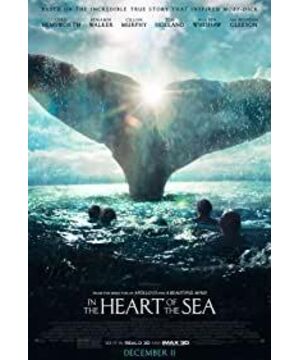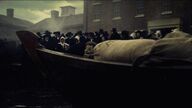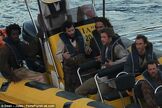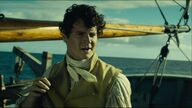On November 20, 1820, deep in the South Pacific Ocean, far away from land, an American whaling ship was hit by an angry giant sperm whale. The 20 crew members on board, divided into three whaling dinghies, began a long sea rafting. They endured extreme hunger and thirst, and crazy despair. They were getting weaker and dying. Three months later, the person who was finally rescued had survived by swallowing the bones of the dead companion.
This is one of the most famous shipwrecks in the 19th century. To this day, this shipwreck experience described by the survivors is still shocking.
*Former Whaling Power*
In the United States today, as long as it talks about killing whales, everyone is filled with indignation. It is incredible that more than a hundred years ago, the United States was the world's leading whaling power.
In North America in the 18th century, with the development of industry and the rise of cities and towns, there was an increasing demand for lighting oil and mechanical lubricants. Europe was also experiencing the industrial revolution. At that time, there was no oil production, and whale oil became a hot commodity. The elastic baleen (Baleen) is used as plastic, and the popular women's corset is made of baleen, which is in great demand. The whaling industry has become a lucrative industry. Nantucket Island in Massachusetts on the Atlantic coast, due to its proximity to fishing grounds and a superior geographical location, has become a whaling center, rich in oil, and one of the richest towns in the United States.
By the beginning of the 19th century, whaling ships had undergone long-term improvements to refine whale oil directly on ships and become offshore processing plants. The ships became stronger and stronger. In harsh weather conditions, these ships could go far. The average sailing time is two to three years, or even longer.
With the voyage of the ship, many previously unreached sea areas have also had nautical charts, and the navigation equipment has become more and more sophisticated. American whaling ships spread all over the world, sailing in the most remote waters.
The writer Melville was inspired by the shipwreck and wrote the novel Moby-Dick.
Nantucket Island is the home base of the American whaling industry. There are more than 70 whaling ships on the island. The Essex is one of them. This is an old ship, small, only 87 feet long, and has a displacement of 238 tons. But it has always been very lucky and has not had any major incidents. . After repairing before the voyage, it was equipped with sufficient supplies and set off from Nantucket on August 12, 1819, embarking on the planned two-and-a-half-year voyage. The captain is 28-year-old Pollard, first mate Chase is 22 years old, and the second mate is Joey. Among the crew are javelinmen and helmsmen. The youngest is 14-year-old Nicholson, a boy full of curiosity and pride. He was a small handyman when he set sail for the first time. There were 21 people on the ship. Later, one of the crew members left without saying goodbye in the middle of the journey, and his whereabouts were unknown.
Three days after setting off, on August 15th, the Essex encountered a strong storm. The ship trembled and tossed in the overwhelming stormy waves. The two small boats used for whaling hanging on the side of the ship were swept away by strong winds and waves. , The boat at the stern was also cracked by huge waves, the upper mast was damaged, and it almost sank.
The storm finally passed, and only two of the five whaling boats were left with only two small boats, and the whaling operation required at least three small boats. Now there is a dispute about whether to look back or move on. The captain wave Ladd finally accepted the opinions of the first and second mates, and agreed to repair and continue to move forward. They still need at least two spare boats. Fortunately, they finally encountered a whaling ship that wrecked and bought one. The whaling boat can still be repaired.
*Life at sea*
In January 1820, Essex broke through many difficulties and bypassed Cape Horn, the southernmost tip of South America. After five months of sailing, only one whale was caught. The crew was depressed and headed north along the Chilean coastline. , Gradually entering the warm waters of the South Pacific, and still nothing at first, until they reached the coast of Peru, they encountered whales one after another. After two months of hunting, they refined 450 barrels of oil and caught 11 whales on average. Kill a whale every five days, and everyone is exhausted.
The target of the hunt is the sperm whale. Its blubber is of the best quality and can extract very clean and bright lamp oil. Its square head stores excellent whale brain oil, which is very profitable.
Whaling is a very dangerous industry. When they encountered a group of whales, they put three whaling boats down into the sea and rowed towards the group of whales as quickly as possible. When they approached, the javelinman raised his bright javelin and threw it at the huge whale. Go, you must be steady, accurate, and ruthless. You often have to shoot more than a dozen times. There is a whaling rope behind the javelin. The shot whale drags the roped javelin and rushes forward. The boat is dragged and rushed on the sea. The whale is huge. His body was tossing and struggling, and it was possible to overturn the boat at any time, the waves were noisy, the foam was flying, the boat bumped up and down in the huge waves, until the blood stained the blue sea, and the whale died tragically in his own pool of blood. This hunting process generally takes tens of minutes to several hours.
The distance from the whaling boat to the big boat is generally five nautical miles. After the small boat drags the heavy whale back to the big boat, it takes three days to peel off the whale oil. They cut off a 5-foot-wide strip of whale meat, and then put 6 An inch-thick, hard whale blubber is cut from the meat. As soon as the heavy whale meat hung on the side of the ship shook, the whole ship shook violently. They cut off the whale brain and placed it on the deck, dug a hole, and one or two people got in and took out the whale brain oil. The next step is to use cut whale meat sludge as fuel, boil the whale blubber into oil, thick smoke billowing, the ship is full of stench, blood and oil are everywhere, and the crew work in shifts for days in the smoke and fire. One by one was almost exhausted and fell apart. Until the oil was put into the barrel and the deck was washed clean, what awaited them was the next round of thrilling pursuit.
In May 1820, the Essex encountered a whaling ship from Nantucket. The ship from my hometown brought news of a new fishing ground: from the coast of Peru to the west, there are many sperm whales roaming deep in the ocean more than a thousand miles away. In order to bring back more whale oil, the Essex decided to head to the remote waters that are inaccessible.
They made a short stop in the South American continent, loaded fresh fruits and vegetables, and started sailing west. During the voyage, they stopped at an island rich in sea turtles, braved the scorching heat, and caught hundreds of pieces that weighed 80 pounds or even four. Large turtles over a hundred pounds, because turtles can live for a long time without eating or drinking, and their meat is mellow, they are regarded as a source of fresh meat without feeding costs.
Entering November, the Essex sailed into the sea more than a thousand miles away from the South American continent, and a crew of people was looking forward to encountering a group of whales.
*Shocking Shipwreck*
At 8 o'clock in the morning on November 20, 1820, people at the lookout saw a jet of water, and three whaling boats dropped the water again. First officer Chase led the boat to throw a fishing fork and hit the sperm whale. The huge whale was in pain. The big tail slammed and hit the ship's side, cracking the plank, and the sea water poured in. They had to act decisively, cut off the whaling line, and let go. After the whale was removed, the boat was towed back to the ship for repair.
Everyone is busy with work. Chase accidentally looked out. On the sea not far from the bow, there was a huge sperm whale floating quietly, probably weighing 85 tons, but because whales have always been kind and never No one cared too much about attacking the ship, but something unexpected happened in an instant. It rushed towards the whaling ship at full speed. Chase shouted and ordered the helmsman to turn the rudder. The voice did not fall, the huge whale The head had hit the front of the ship heavily, and the ship was thrown up by this sudden slam. The crew leaned forward and reunited. The whole ship was like hitting a rock. Within a few minutes, it trembled, like leaves shaking in a strong wind.
Everyone was stunned and couldn't say a word. The whale rubbed the keel heavily from the bottom of the boat, knocked off the bottom plank, and appeared beside the starboard side, with its head leaning against the bow and stern against the stern. It seemed that it was also fainted and motionless. Chase immediately thought of using a fishing fork to fork it from the deck, but on another thought, its whale tail is next to the rudder. Any stimulation will make it struggling to destroy the rudder, in the ocean thousands of nautical miles away from land. Deep down, that can't be done!
Realizing that a vicious accident had occurred, Chase ordered everyone to prepare pumps for pumping water and signaled the other two small boats. At this moment, a person standing in the hatch of the ship suddenly exclaimed: "Look! It rushed over again!" Chase turned around abruptly, and saw that the giant whale had recovered in a short moment and swam to it. 550 yards away, he rushed over at double speed and rolled up the white soaring waves. Chase tried to change its course to avoid the impact. However, the speed of the ship was far lower than that of the whale. It hit the ship again and again. It crashed the bow and knocked the 238-ton ship back. Then he passed through the bottom of the ship again, broke through the waves, and disappeared in the vast blue ocean of the South Pacific.
Shocked, without much thought, the black steward Bond rushed into the sinking ship cabin and rescued the two boxes of the captain and chief mate, which contained a compass, a nautical quadrant and a navigation book. These are the eyes of the navigator. , There are pistols in the box. They dragged the small boat from the side of the ship into the water before the big ship capsized.
The other two boats saw the signal on the top of the mast and hurried back, everyone was shocked.
Captain Pollard immediately ordered the mast to be cut off, so that the hull could be straight, and ordered everyone to quickly salvage food and fresh water from the sinking ship, which will be the lifeblood of future survival. They used axe to chisel a few on the deck. They grabbed boxes of hard biscuits, dry bread, 200 gallons of fresh water, some tools, and some live turtles that were caught for meat before. In order to let the big boat shelter the small boat from the wind and waves, they put three small The boats are tied together and tied to the big boat. Everyone was busy until night fell.
The next day, in order for the three small boats to cope with future drifting, they used logs from the big boat to make masts, tore off the sails, cut out the sails and hung them up, and used wooden boards to raise the sides of the boats. More than half a foot in order to reduce the influx of seawater. This is a key step. Each small boat is equipped with 60-day rations, 65 gallons of fresh water, and two turtles, candles, lights, ignition boxes, Small axe, fishing fork, fishing hook, shovel, spear, etc.
The next most important question is where to sail. The shortest southwest to Marquesas Island, but it is 1,200 miles away. Captain Pollard thinks that riding the trade monsoon is the only option, because Only by taking that route can they reach their destination before they run out of food. The other route is to go southeast to South America, which is much further.
First Mate Chase and other leaders would rather go far, because they had no idea what happened to the island of Marquesas at the time. According to legend, there are natives who cannibalize. They feel that going to that place is better than dying at sea. Their opinion is: If there is no trade monsoon, go south for a month, about 1,500 miles, and enter a sea with variable wind directions, and then use these winds to try to go east. If "all goes well", go for another month. They have arrived in South America. Their fresh water and bread can last for two months. Of course, they hope to meet other ships on the voyage, but in fact the so-called "all going well" is almost impossible.
Many people later believed that if Captain Pollard's route were followed, it was very likely that everyone would survive. After all, this is a shipwreck drifting, no matter which direction it is going, no one is very sure about it. Distress is at stake, not a time of quarrel, as the few Captain Pollard gave in.
*Who knows to whom? *
After two days of preparation, on November 22, 1820, the three whaling boats set foot on the boundless road. The best hope is to encounter a sea boat. If two months later, they are still drifting at sea, I am afraid It is difficult to survive. The captain, chief mate, and second mate are in charge of a boat each, and each has a gun and some ammunition.
First mate Chase’s ship was hit by a whale, and it was already crumbling. On November 25, it cracked again and was repaired. There was still water seeping in. What's worse was that some bread was soaked in the brackish sea. At the same time they have to scoop out water continuously, making people exhausted. On the night of November 27, Captain Pollard’s ship was hit by a whale or a big shark in the dark. The sea water entered and the lights were quickly turned on. The people on the three ships rushed to repair it. Although the leak stopped, some of the bread was also damaged. The sea soaked, and the people who ate the salty bread went crazy with thirst.
One day, groups of dolphins were playing and jumping on the side of the ship. The hungry people on the ship were really eager to eat a bite of fresh food, but they could not catch a lively dolphin in every possible way. Everyone was so hungry that they decided to kill the turtles, and even eat the intestines with their stomachs, and eat the juicy fresh meat. It felt amazing.
By December 3, I had finally eaten the brackish bread soaked in the sea. The next night, a storm struck and the second crew of Joey’s boat suddenly disappeared into the darkness. They lighted the lights and looked around and saw the distance. A little light flashed on the surface of the sea, and that was Joey's response. Since then, such gatherings and dispersions have become more frequent, and it is too difficult for the three small wooden boats to stay together in the depths of the unpredictable ocean.
Floating at sea for 18 days, first officer Chase locked the dwindling hard bread in the box, loaded the bullets, guarding the lifeblood vigilantly, and swarms of flying fish passed by the sea that afternoon, and some of them hit the sea. On the sails, fall onto the boat. marvelous! It was a god-given delicacy, and people rushed to devour the live fish they caught.
Constant thirst is more terrifying than hunger, and it tortures everyone every minute and every second like torture. In mid-December, Chase, who was under strict management, halved the bread supply on his dinghy. The trade wind passed and the sea was calm and sparkling. However, summer in the southern hemisphere came, and the weather became hotter day by day, exposed to the sun. People have nowhere to hide. Some people jumped into the water to get bubbles. They found some crustaceans attached to the bottom of the boat. They immediately peeled off the meat and swallowed them in their stomachs. In fact, the wrecked seafarers can often catch some marine fish for a living. Unfortunately, It was they who entered an extremely desolate sea area. Due to natural reasons, there were no edible creatures here.
Chase’s crashed ship, the water leaks more and more at this time, people are already extremely weak, and they have to do everything possible to repair the boat to scoop the water. , Where is the end!
*what! Kojima*
On December 20, 1820, a month after the sinking of the Essex, a cloud of despair hung over the drifters' hearts. Suddenly, there was a shout: "Land!" There was a burst of ecstasy, it was as if a paradise appeared in front of you. Looking into the distance, a small island surrounded by reefs was in front, and they were very careful to row towards the island.
Although the island was desolate and rocky, everyone searched carefully and hopefully. When almost giving up, they found a spring water on the low tide near the sea. There are only a few stubborn tree species that survive hard on the island. The crew desperately search for anything that can be eaten, devouring birds, bird eggs, crabs, shellfish, lone grasses, seagrass...what to eat, less than a week At that time, almost everything on the island was wiped and swept away. The birds that originally inhabited the island were harassed and frightened and evacuated one after another.
On December 26, 1820, after six days on the island, they pushed the boat into the water again. Three non-Nantukites on the crew expressed their willingness to stay on the island without any objections. In this way, the boat can reduce the weight of the three people, and the rations they keep on board are of course very precious. On the other hand, these three people were on a small island with spring water, in the words of First Mate Chase later: "The possibility of survival is far greater than the possibility of us reaching the mainland."
The captain and chief mate have been using navigational instruments to locate. They thought that the island was Dicy Island, but it was actually on Henderson Island, seventy miles west of Dicy Island. They drifted for nearly 1,500 nautical miles, which was more than they were away from South America when they set off. The mainland is farther. But in any case, this less than a week on the island gave them the possibility of survival. The crew drank enough spring water, ate all kinds of game and aquatic products, filled wooden barrels with water, dried clothes, repaired the boat, caught some birds, caught some fish, and dried them and took them with them. Now Time to leave.
*Cannibalism*
The wind direction on the sea changes in this area. Sometimes squally winds and waves, sometimes scorching sun like fire. Half a month later, on January 10, 1821, the second mate Joey, who had been ill, finally died. Javelinman Hendricks replaced him and was in charge of a whaling boat. The next day, the three small boats were separated in a storm. The captain and Hendrix’s boat were later reunited, but the first officer Chase’s boat never knew where it was drifting.
As the second officer Joey was sick for a long time and was unable to strictly control the distribution of rations, when he died, there were only two days of rations left on his boat. Captain Pollard had to divide the rations on his boat among them, and soon the rations on both boats were consumed. From January 20th to January 28th, four more people died one after another. The living people were driven by crazy hunger, and they agreed that they had no choice but to eat the bodies of their companions who died.
On the night of January 29, the sea was dark, and Hendrix’s boat and Pollard’s boat were separated. Like many seamen, the four people on the boat disappeared into the ocean forever, and no one has seen them ever since. The boat of Captain Pollard was left drifting lonely on the sea. The four people on the boat are all from Nantucket. They are all very young. They know each other well and are relatives, friends, and acquaintances. The captain's cousin Coffin is only 18 years old, his friend Ramsdale is younger, and there is another crew member, Ray. They survived day after day by "cannibalism". By February 6, 1821, even the dead were eaten up. They were so hungry that they were unkempt, unkempt, like people and ghosts.
In the midst of extreme hunger, a creepy thought kept circling in the minds of these four people...Finally, the 16-year-old Ramsdale spoke: Let’s draw lots to see who should die. . At first, Captain Pollard ignored him, but there were four people in total. His cousin and crew Ray both stood by Ramsdale's side, leaving him no choice, so let's draw lots. As a result, the death sign fell into Coffin's hands. As the cousin, the captain once vowed to the family that he wanted to protect this young cousin. At this time, he shouted hoarsely: "My child, my Boy! If you don’t like your sign, I’ll kill the first person who dares to touch you.” The poor and extremely weak boy hesitated...but then, quietly, he leaned his head on the ship’s side. Side, said: "I like it like other picks."
At this moment, they are facing another difficult decision. Who will execute the shooting? Only draw lots again. As a result, this chilling errand fell on Ramsdale's head, and even though it was his proposal, he quit at this time. He begged Coffin: Let me die! But it was rejected by Coffin. Since everyone had equal opportunities, he was determined to accept his destiny. Ramsdale finally raised that heavy gun and aimed it at his friend who had been playing with him since he was a child... Coffin asked him to be quiet for a few minutes. Now, leave a message asking them to bring it to the mother far away. He didn't want anyone to feel guilty about it, and before leaving, he didn't forget to say: "The lottery is done fairly." Then he went to death peacefully.
Five days later, the crew member Lei also died in the misery on February 11, and once again became food for his surviving companions. Only the captain Pollard and Ramsdale were left on the boat, gnawing on the bones of their companions, dying, still alive.
Another 20 days have passed.
On the early morning of February 23, 1821, the American whaling ship Prince Prince was heading north along the Chilean coastline. Someone at the lookout spot spotted a very strange floating object in front of it, which went up and down in the waves. The captain Zimmery Coffin tracked with a binoculars curiously, and soon discovered that it was a whaling boat, the sails were faded by the sun, and no one was paddling. He gave an order to the helmsman: turn the rudder forward. The moment they approached the boat, everyone was stunned by the sight in front of them.
The first thing I saw were bones, human bones, scattered on the deck and the bottom of the boat. On both ends of the boat were two people curled up, their skin ulcerated, their eyes protruding from their sunken eye sockets, and their beards were covered with stiff salt and blood clots. Holding the broken bone in his hand, sucking the bone marrow. They didn't even notice that the ship approached, and saw the rescuers uncharacteristically, not ecstatic, but panic, clinging to the bones in their hands.
They carried these two seemingly terrifying people onto the big boat. With food and water, life slowly returned to them.
From the shipwreck on November 20, 1820 to their rescue on February 23, 1821, their shipwreck drifted for three months and three days. At this moment, they had no idea whether the other crew members were still in the world.
*First Mate Chase and their crew*
Turning back to First Mate Chase’s boat, they were separated from the other two boats during the violent storm on January 12th.
On January 15th, a large shark followed the first officer’s boat and attacked again and again. The people on the boat were hungry and dizzy. At first they wanted to catch the sharks and eat them. Finally, they found that they didn’t even have the strength to throw a fishing fork. I had to try my best to drive the shark away.
On January 20, the black Peterson died, and the crew buried their companions by sea. On February 8, they drifted at sea for two months and 18 days. As the first officer said: "A terrible death is obviously waiting for us. When we are hungry to the extreme, our ability to speak and think is getting worse and worse. We are the most helpless poor people among mankind." In extreme despair, the crew member Cole went crazy, convulsed, yelled and moaned, and at 10 o'clock in the morning he could no longer speak, the first mate recalled later. "He was lying unconsciously on the bottom of the boat... Let's cover him with clothes and let it be his fate. He lay there moaning, very pitiful, until 4 o'clock in the afternoon, he was the most I have ever seen. Died in the tragic and terrifying convulsions."
When everyone was preparing for the sea burial for Cole, Chase finally said the most difficult thing to say: It is better to leave the corpse for food. no disagreement.
On February 15th, the flesh of the dead had been eaten. In the end, a small portion of two pieces of bread was left for each person. Their limbs were swollen and painful.
Finally, on February 17, there seemed to be signs of land ahead. Chase tried his best to persuade and comfort Nicholson, who was only 15 years old and a child, lying there waiting to die. After all, suffering is extremely difficult, and death is easier than living.
*Finally rescued*
At seven o'clock in the morning on February 18, 1821, Chase was awakened by the call of "Sail!", even though he was extremely weak, he immediately stood up. Staring at the magical fan shadow like an illusion, his expression trance, ecstatic. Even the desperate boy Nicholson suddenly became angry and stood up to his feet. With a desire to survive, they tried their best to row towards the big boat and chased them for three hours.
Finally, someone on the big ship saw them and moved closer to them. The three survivors were carried on the big ship, each looking terrifying. The captain saw their miserable condition from the back deck, tears bursting into his eyes. In nearly 90 days, they drifted about two thousand five hundred nautical miles at sea. The rescue ship is the Indian merchant ship. Chase’s boat was rescued five days earlier than Pollard’s. In March 1821, five survivors on two whaling boats reunited in Valparaiso, Chile's great port!
The American consulate was stationed here. Pollard, the still weak captain, was worried about the three crew members stranded on Dicy Island. After the consulate arranged, the captain of the British Merchant Marine Surrey, which was about to set sail for Australia, promised to help. You can slightly adjust the route and make a detour to save people on the island. The compensation fee is US$300. However, when the Surrey arrived at Dicy Island, it was found that there was no trace of anyone visiting. Fortunately, Captain Lane did not give up easily, but headed for Henderson Island 70 miles west.
The three crew members remaining on the isolated island are still alive, relying on a little bit of wild fruits, shellfish, seabirds, bird eggs and so on to barely sustain their lives. The most lacking is water, because the small spring has been submerged by sea water since the day they stayed on the island. The water stored in some crevices when it rains is their life-saving water. While looking for water, they found a cave with eight skeletons of people lying side by side. They were shocked and couldn't help feeling sad.
On April 8, 1821, the three crew members who were almost desperate on the desert island suddenly heard gunshots. When they stumbled and stumbled to the shore, there was a sea ship in front of them. I saw a small boat dropped from the Surrey. But the water is covered with sharp coral reefs and it is impossible to sail. Chabel, the only one of the three who knew water, jumped into the water, swam to the side of the boat, and was pulled aboard. He tied a cable to his waist, swam back to his companion, and took the two companions to the boat. Despite being wounded everywhere by the coral reef, the last three survivors of the Essex were rescued.
After their guidance, Captain Renne found a tin box nailed to a tree on the desert island, and inside it was a short note written by Captain Pollard, describing the crash. There is also a letter for his wife. The captain wrote: "Leave this letter to my wife here, and whoever finds it and forwards it in good faith will be grateful to an unfortunate person."
Among the 20 crew members of the Essex, A total of 8 people survived. Among the 12 people who died while drifting, 7 were eaten by their companions.
Soon the survivors on the three islands returned to their hometowns. They were not from Nantucket, and there is no record that they returned to the sea again. The other five survivors returned to the ocean one by one within less than a year after returning to Nantucket.
Captain George Pollard became the captain of the whaling ship "Two Brothers". Unfortunately, his ship wrecked again at sea and sank on a rock near Hawaii. The crew squeezed into two whaling boats in the wind and waves and drifted on the sea overnight. This time they were much luckier, and they were rescued by another sea ship early the next morning. However, Captain Pollard has always become a symbol of "bad luck" and he can no longer enter the whaling industry. Since then, he has been a night watchman on land and spent the rest of his life quietly. He locked himself in his house and fasted every November 20th to commemorate the victims of the Essex until his death on February 1, 1870, at the age of 81.
Chase achieved the position of chief officer in 1832 and became a whaling captain, earning a lot of money. Retired at home after 1840, life is very good. However, after entering his old age, he became insane and kept buying food and hiding in the attic and basement. A severe headache afflicted him, nightmares continued at night, and he was finally sent to the hospital, where he died at the age of 73 on March 7, 1869.
After Chase returned to Nantucket, he wrote about the shipwreck in just a few months and was published in 1821. His book provided a valuable first for many articles and books about the shipwreck. Hand information. Melville, the author of Moby-Dick, was inspired by Chase's account to complete his masterpiece.
The crew member Ramsdale later became a successful whaling captain. Understandably, even when his son asked about the shipwreck, he didn't say a word. The reason is simple. Unfortunately, Ramsdale got the "execution shot" lottery. No matter how reluctant it is, he killed his friend with his own hands. This is the trauma of eternal bloodshed in his heart.
Lawrence and Nicholson, two other Nantucket crew members, later became whaling captains. Among them, Nicosen was only 14 years old when he boarded the ship. It was the first time he went to sea and was the youngest crew member on the ship. In his later years, he wrote an article about the shipwreck, but for some reason it was not published. It was not discovered in the attic of a New York State until around 1960, and it took another 20 years before it fell into the hands of an expert who had studied the shipwreck.
The Essex shipwreck was a desperate struggle for survival among humans. Although there were tragedies such as "cannibalism", we cannot fail to say that the man in this ship was indeed not. A group of mobs, but a team of real seafarers who are organized, disciplined, and have sailing skills.
On the sinking ship, they did not get into chaos, but raced against each other and saved themselves efficiently. In the maddening water shortage and hunger, there was no looting, but everyone silently took their pitiful share. In the vast ocean, they have been using nautical charts, quadrants, and compasses as their eyes to guide the course, and more accurately positioned Henderson Island, so that the three crew members who remained on the island were finally rescued. Even "eating dead bodies" is a collective decision. In the depths of the ocean far away from civilization, Captain Pollard with a gun in his hand did not join forces with his cousin to kill the other two people on the boat. Instead, everyone draws lots so that everyone is equal before the chance of life and death. . It's not accidental to be able to live for eight or ninety days of drifting.
Looking back at history, the 19th century was the era of great development in the United States. An increasingly powerful United States is emerging, and the whaling industry is an extremely important part of this development wave. It is generally believed that the period from 1820 to 1860 was the golden age of the whaling industry in the United States. As many as 250,000 sperm whales were killed.
The sperm whale floating quietly on the surface of the Essex suddenly attacked the Essex. Isn’t it a vivid portrayal of nature’s lack of intelligence?
View more about In the Heart of the Sea reviews











